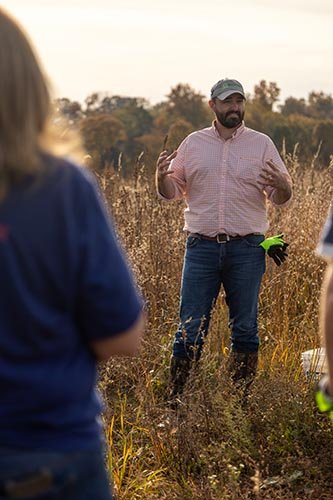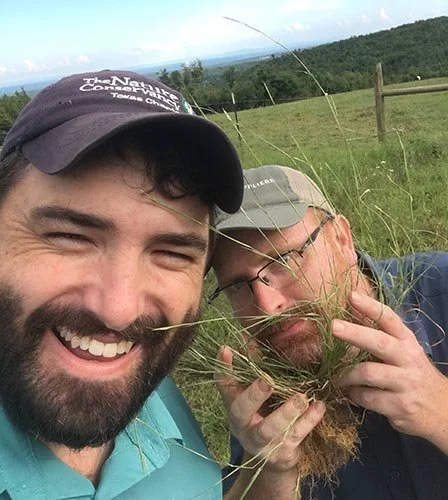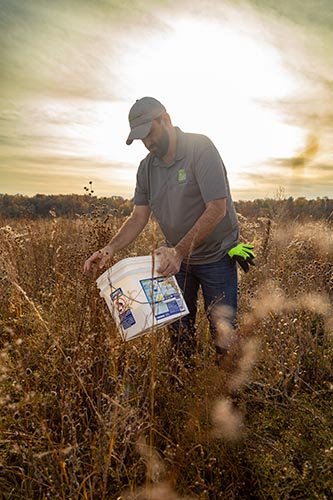Dwayne Estes is the Executive Director and co-founder of the Southeastern Grasslands Institute. He is also a Professor of Biology and Principal Investigator with the Center of Excellence for Field Biology at Austin Peay State University in Clarksville, TN where he has mentored more than a dozen graduate students.
His enthusiasm and love of Southeastern grasslands, botany, and natural history is infectious as anyone who has had the opportunity to talk with him can attest. Recently we sat down with Dwayne to learn a little more about him and his role at the Southeastern Grasslands Institute.
Q: Were you always interested in nature and the outdoors or is that something that you became interested in later?
I have always been interested in the outdoors. I was a roamer, even as early as 4 years old in my hometown of Pulaski, Tennessee. When I was in the 5th grade, we moved way out to the country and my roaming escalated and I would roam even farther, sometimes a few miles from home. I remember leading my little cousins who were 4 or 5 years younger than me on an “expedition” about three quarters of a mile back into the woods, and hearing my uncle driving the road honking his horn looking for us.
My roaming naturally just led me to do all the things you do as a kid. The outdoors were my playground. Everything that I needed to have fun, I experienced in the outdoors. And because I was also a naturally creative kid, I combined my creativity with this love and fascination of exploring . I built huts in the woods and pretended to survive off the land. I became interested in what plants were edible, which was one of the paths that led me to become interested in botany. All in all, these experiences paved the way for me to stumble into the field of natural history.
Q: How did you get interested in grassland ecosystems?
From the time I discovered botany as a 12-year-old until probably my first or second year of college, all I did was study plants, at least 3-4 hours per day, everyday. I wanted to identify every plant I possibly could. But then when I got into college, all that knowledge that I had obtained about how to identify plants began to grow into a deeper knowledge of ecological interactions among species, habitat preferences, and biogeography. It was at that time that the concepts of things like “rarity” began to sink in. I realized that I didn’t see some plants very often. I only found them in certain types of places or habitats. I could see that some species were getting rarer due to human actions.
Then while dating my wife in college, I was driving to her house to pick her up for a date and I spotted an open limestone glade along the roadside. It was beautiful and fascinating and I had never seen anything like it. I visited it every chance I got, and sometimes I was late for our dates because I was so engrossed in studying the plants in that little glade. To make up for it I would bring her a bouquet of freshly picked flowers of species like Gattinger’s Prairie Clover, Glade Larkspur, and Nashville Breadroot. In the spring of the year, it was just covered by spring wildflowers and glade endemics. I became insanely curious about these glade ecosystems – why they were there, how they formed, and all that stuff.
While exploring the glade ecosystems of Giles and Maury counties, Tennessee, in the late 1990s and early 2000s, I ended up discovering a new species of plant that is only found in little pools and streams in glades. It was through the discovery of that new species, Quarterman’s Hedge Hyssop (Gratiola quartermaniae), and getting ready to publish the discovery that I had to completely immerse myself in the literature about limestone glades.
As I got deeper into it, I realized that these were rocky grasslands that are found in the Southeast. And, I began to understand how glades compare to other types of naturally open ecosystems like barrens, prairies, meadows, and savannas. My research and fieldwork exposed me to their amazing biodiversity, the threats they face, the ecology of the glade ecosystem and its species, and how these glades have changed over historic and prehistoric time periods.
Later when I met Theo Witsell in 2008, we had long conversations about many of the species we wanted to see or the ones that we thought were disappearing. Together we realized that many of the species we were mutually interested in are ones that need open landscapes. That led to deeper philosophical conversations about the fact that these species are dependent on grasslands, and “why is that?” and “wow, not many people are really thinking about or talking about this.” Those conversations led to us eventually founding SGI because we both felt an almost moral obligation to do something to help protect these vanishing grassland ecosystems and raise awareness about them.
Q: What is your role within SGI?
My role is co-founder and Executive Director. As co-founders, Theo and I have played every role there is to play in the organization. At times when there was no one else to join us we handled the science, communications, fundraising, publications, research, fieldwork, outreach, report writing, and everything else. It was a lot. Thankfully now that we have a team to help with those tasks, my role has gotten a lot smaller. I work hand-in-hand with our Director of Operations & Finance, Layla Dunlap, who oversees the day-to-day activities of SGI and I communicate daily with Layla and Theo.
My job is divided into 3 realms. Specific to SGI, my role these days is focused on the big picture, helping to set the vision for our organization, meeting with regional and national leaders, making sure grasslands have an equal seat at the conservation table, and working closely with Layla on guiding the organization. A big part of my job is fundraising to support our programs and team members.
Many may not realize but I’m still an active professor at APSU where I’ve been teaching for 15 years. This semester, I am teaching Natural History of the Mid-South course which has 10 graduate students. I also mentor 4 active graduate students who are pursuing their master’s degrees in the Biology Department at APSU. Each one is studying various aspects of Southeastern grasslands for their research.
Finally, as a PI in the Center of Excellence for Field Biology, I also am engaged in my own research which includes incorporating botany, natural history, and ecology. I’m leading a research team right now on publishing a review paper of riverscour grasslands of the eastern U.S. and collaborating with Reed Noss, our Chief Science Advisor, as well as numerous other collaborators, on an exciting new paper about grasslands of the Cumberland Plateau.
Q: Early on, you were often referred to as the “Prairie Preacher” and that name is still sometimes applied to you. Where did it come from?
That’s a good question. I don’t really know. I think someone gave it to me in 2017, the year before SGI was officially formed. I gave 67 presentations that year in something like 20 states. I think it was during that time period that someone gave me the moniker of “Prairie Preacher.” It fits well, especially given that we “preached the gospel of the grasslands” to over 10,000 people in our first 3 years.
Q: What are you most excited about when it comes to SGI?
I’m excited about multiple things, but I think the thing I am most excited about is that we have some opportunities at hand to do large-scale grassland restoration work and have those sites be open to the public. We’re hoping to create these destination places where people can come and experience grasslands.
We are doing some exciting work right now in the Black Belt Prairie region of Alabama working on large-scale savanna and prairie restoration with Sumter Farm & Stock Company. We are about to double the size of our restored prairie with Google here in Clarksville. And just 30 minutes north of Nashville we are about to embark on restoring 500 acres of prairie, savanna, and prairie wetlands with Whitfield and Teresa Hamiton, who own about 5,000 acres in Robertson County, Tennessee in the heart of what was formerly the South’s largest prairie landscape. The thought of rebuilding 500 acres of prairie excites me and inspires me to work harder!
Q: What are some of your hobbies?
I’m not sure I have any because most of my hobbies have grown into my career. My hobby was always plant identification and that naturally grew into a career in botany. One of my other loves is geography. I loved maps as a kid and still do. I also love art and have dabbled in watercolors and botanical illustration.
Probably my biggest hobby nowadays, and I’m still not sure I see it as a hobby – I see it more as an outgrowth of my career interests – but I love trans-Appalachian American history. So, I read a lot about American history, early exploration by explorers and accounts of early settlers, and that timeframe from around 1600 to 1800 in Virginia, Tennessee, and Kentucky. I just love that time period in American history.
I’m also coupling this newfound passion for cultural history with my pre-existing fascination with natural history and my love of writing and am working on a book project behind the scenes called the Natural History of the Mid-South. Not sure when I’ll find time to wrap it up, but in my spare time I write on this book at least a few hours a week.
SHANNON TRIMBOLI, INTERIM DIRECTOR OF COMMUNICATIONS
Shannon helps the Southeastern Grasslands Initiative tell the forgotten and untold stories of our Southeastern grasslands.







